Kerang Rail Crash Analysis: Policy, Safety, and Accident Prevention
VerifiedAdded on 2019/10/31
|9
|2149
|288
Report
AI Summary
This report provides a comprehensive analysis of the Kerang rail crash, a significant train accident that occurred in Australia in 2007. The report delves into the causes of the accident, focusing on policy failures, lack of public awareness, and inadequate safety measures, such as the absence of automated warning signs and the use of rumble strips. It examines how poor railway policies and insufficient road signs contributed to the crash. The report highlights the importance of implementing effective government policies and regulations to reduce the risk of cross-level accidents. The report also discusses the human factors involved, such as driver negligence and lack of attention, and suggests the importance of public awareness campaigns and automated safety systems. The report concludes by emphasizing the need for governments to prioritize road safety and implement measures to prevent future accidents. The report also refers to the Transport Safety Investigation Regulations 2003 to reinforce safety measures.
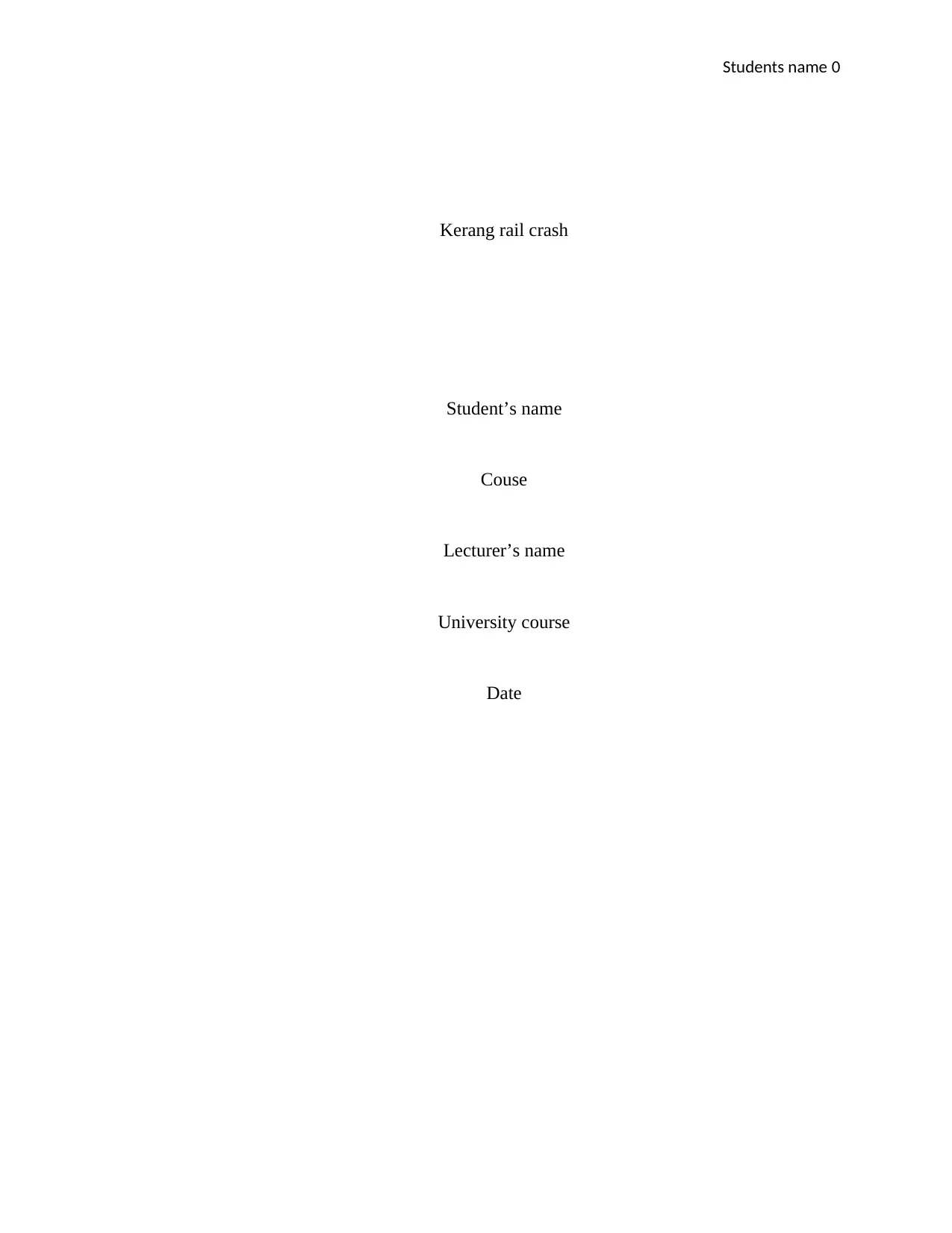
Students name 0
Kerang rail crash
Student’s name
Couse
Lecturer’s name
University course
Date
Kerang rail crash
Student’s name
Couse
Lecturer’s name
University course
Date
Paraphrase This Document
Need a fresh take? Get an instant paraphrase of this document with our AI Paraphraser
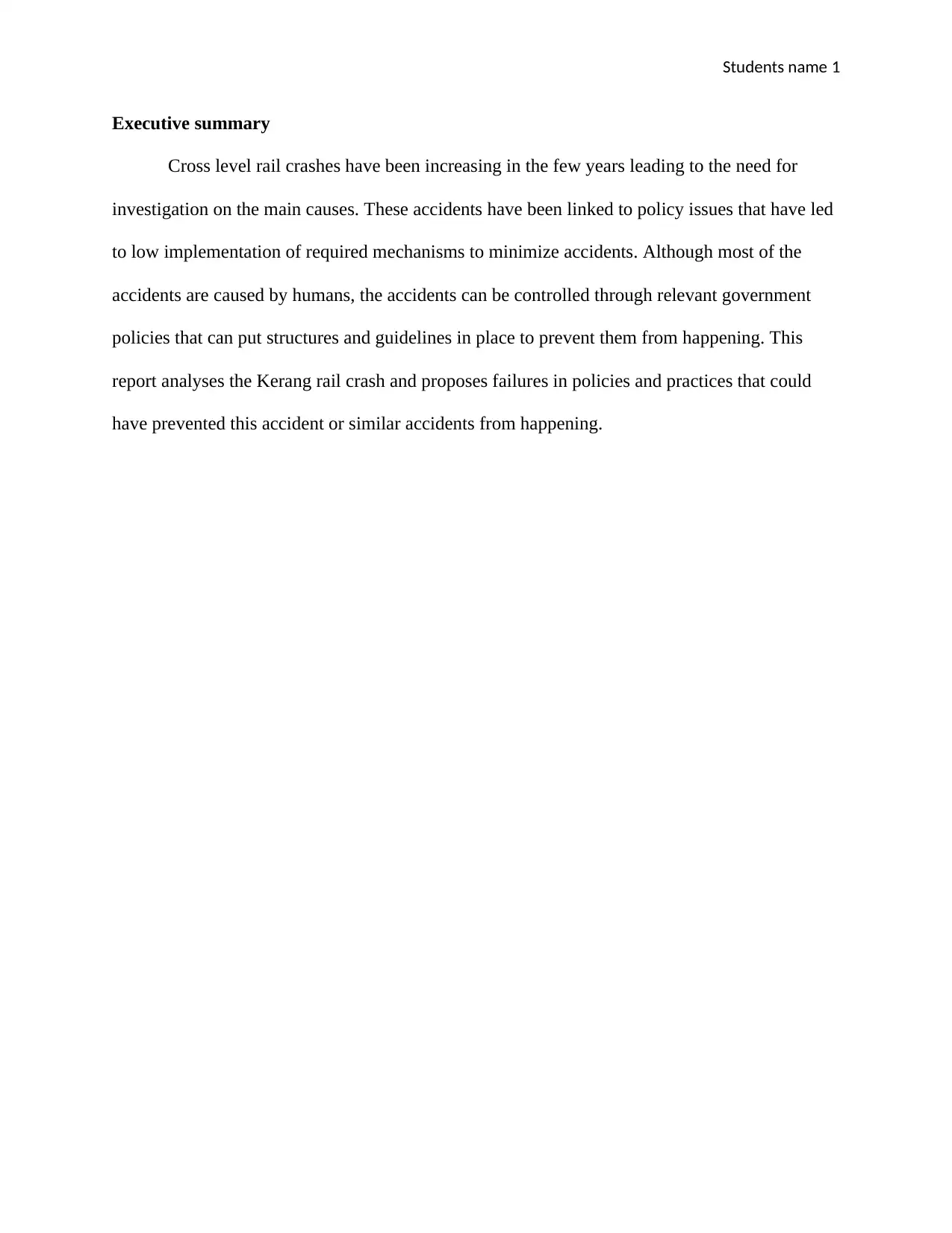
Students name 1
Executive summary
Cross level rail crashes have been increasing in the few years leading to the need for
investigation on the main causes. These accidents have been linked to policy issues that have led
to low implementation of required mechanisms to minimize accidents. Although most of the
accidents are caused by humans, the accidents can be controlled through relevant government
policies that can put structures and guidelines in place to prevent them from happening. This
report analyses the Kerang rail crash and proposes failures in policies and practices that could
have prevented this accident or similar accidents from happening.
Executive summary
Cross level rail crashes have been increasing in the few years leading to the need for
investigation on the main causes. These accidents have been linked to policy issues that have led
to low implementation of required mechanisms to minimize accidents. Although most of the
accidents are caused by humans, the accidents can be controlled through relevant government
policies that can put structures and guidelines in place to prevent them from happening. This
report analyses the Kerang rail crash and proposes failures in policies and practices that could
have prevented this accident or similar accidents from happening.

Students name 2
Table of Contents
1.0 Introduction.........................................................................................................................................2
2.0 Causes of cross level accidents............................................................................................................2
2.1 Lack of education awareness to the public........................................................................................3
2.2 Poor railway policies...........................................................................................................................3
2.3 Lack of automated advance warning signs........................................................................................4
2.4 Use of rumble strips.............................................................................................................................4
3.0 Conclusion............................................................................................................................................5
References..................................................................................................................................................7
Table of Contents
1.0 Introduction.........................................................................................................................................2
2.0 Causes of cross level accidents............................................................................................................2
2.1 Lack of education awareness to the public........................................................................................3
2.2 Poor railway policies...........................................................................................................................3
2.3 Lack of automated advance warning signs........................................................................................4
2.4 Use of rumble strips.............................................................................................................................4
3.0 Conclusion............................................................................................................................................5
References..................................................................................................................................................7
⊘ This is a preview!⊘
Do you want full access?
Subscribe today to unlock all pages.

Trusted by 1+ million students worldwide

Students name 3
1.0 Introduction
Train accidents have been on the rise in the few years due to several challenges that have
been attributed to several causes. These accidents have led to many fatalities that have raised
concerns into the causes of these accidents. The Kerang train accident occurred in June 2007 in
the state of Australia in Kerang town. In the accident locomotive, N460 and carriage set N7 were
run into by a semi-trailer truck. This was defined as one of the deadliest accidents in the history
of Australia (Lowe, 2011, pp. 4). This report highlights the train accident by analyzing any safety
breaches that may have contributed to the crash or any changes in policy that may have caused
the crash.
Statistics into many train accidents that have happened all over the world have been
attributed to human errors followed by track defects. These human errors have been attributed to
specific places that need to have been controlled by government policy through following the
right policies when putting up railway lines (Beer, 2010, P. 3). In the case against the truck
driver of the truck that hit the train, the driver’s lawyer argued that the state was the one to be
prosecuted for the deaths and not the driver. This indicates that at one point, there was a policy
issue that was not put in place making the spot that the accident happened dangerously. The spot
where the accident took place is a notoriously dangerously spot that needed adequate following
of road rules.
2.0 Causes of cross level accidents
Level crossing places on any railway line poses greater risks of accidents as compared to
any other place on a railway. The Australia Transport and Safety Bureau (2008, pp. 3) reported
that trains have a greater stopping distance as compared to vehicles which makes it difficult for
them to control cross level accidents. The report further indicates that almost all cases that
1.0 Introduction
Train accidents have been on the rise in the few years due to several challenges that have
been attributed to several causes. These accidents have led to many fatalities that have raised
concerns into the causes of these accidents. The Kerang train accident occurred in June 2007 in
the state of Australia in Kerang town. In the accident locomotive, N460 and carriage set N7 were
run into by a semi-trailer truck. This was defined as one of the deadliest accidents in the history
of Australia (Lowe, 2011, pp. 4). This report highlights the train accident by analyzing any safety
breaches that may have contributed to the crash or any changes in policy that may have caused
the crash.
Statistics into many train accidents that have happened all over the world have been
attributed to human errors followed by track defects. These human errors have been attributed to
specific places that need to have been controlled by government policy through following the
right policies when putting up railway lines (Beer, 2010, P. 3). In the case against the truck
driver of the truck that hit the train, the driver’s lawyer argued that the state was the one to be
prosecuted for the deaths and not the driver. This indicates that at one point, there was a policy
issue that was not put in place making the spot that the accident happened dangerously. The spot
where the accident took place is a notoriously dangerously spot that needed adequate following
of road rules.
2.0 Causes of cross level accidents
Level crossing places on any railway line poses greater risks of accidents as compared to
any other place on a railway. The Australia Transport and Safety Bureau (2008, pp. 3) reported
that trains have a greater stopping distance as compared to vehicles which makes it difficult for
them to control cross level accidents. The report further indicates that almost all cases that
Paraphrase This Document
Need a fresh take? Get an instant paraphrase of this document with our AI Paraphraser
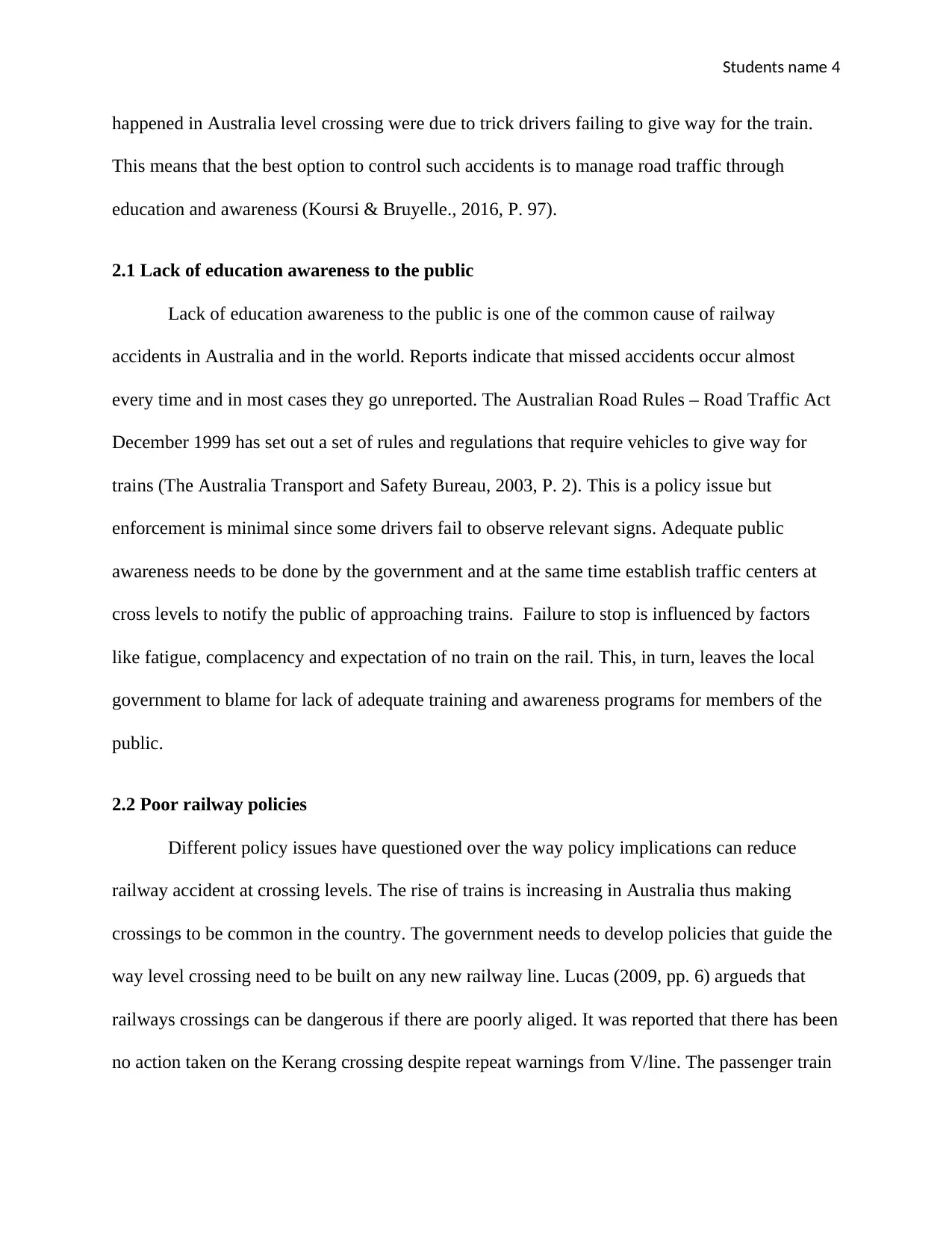
Students name 4
happened in Australia level crossing were due to trick drivers failing to give way for the train.
This means that the best option to control such accidents is to manage road traffic through
education and awareness (Koursi & Bruyelle., 2016, P. 97).
2.1 Lack of education awareness to the public
Lack of education awareness to the public is one of the common cause of railway
accidents in Australia and in the world. Reports indicate that missed accidents occur almost
every time and in most cases they go unreported. The Australian Road Rules – Road Traffic Act
December 1999 has set out a set of rules and regulations that require vehicles to give way for
trains (The Australia Transport and Safety Bureau, 2003, P. 2). This is a policy issue but
enforcement is minimal since some drivers fail to observe relevant signs. Adequate public
awareness needs to be done by the government and at the same time establish traffic centers at
cross levels to notify the public of approaching trains. Failure to stop is influenced by factors
like fatigue, complacency and expectation of no train on the rail. This, in turn, leaves the local
government to blame for lack of adequate training and awareness programs for members of the
public.
2.2 Poor railway policies
Different policy issues have questioned over the way policy implications can reduce
railway accident at crossing levels. The rise of trains is increasing in Australia thus making
crossings to be common in the country. The government needs to develop policies that guide the
way level crossing need to be built on any new railway line. Lucas (2009, pp. 6) argueds that
railways crossings can be dangerous if there are poorly aliged. It was reported that there has been
no action taken on the Kerang crossing despite repeat warnings from V/line. The passenger train
happened in Australia level crossing were due to trick drivers failing to give way for the train.
This means that the best option to control such accidents is to manage road traffic through
education and awareness (Koursi & Bruyelle., 2016, P. 97).
2.1 Lack of education awareness to the public
Lack of education awareness to the public is one of the common cause of railway
accidents in Australia and in the world. Reports indicate that missed accidents occur almost
every time and in most cases they go unreported. The Australian Road Rules – Road Traffic Act
December 1999 has set out a set of rules and regulations that require vehicles to give way for
trains (The Australia Transport and Safety Bureau, 2003, P. 2). This is a policy issue but
enforcement is minimal since some drivers fail to observe relevant signs. Adequate public
awareness needs to be done by the government and at the same time establish traffic centers at
cross levels to notify the public of approaching trains. Failure to stop is influenced by factors
like fatigue, complacency and expectation of no train on the rail. This, in turn, leaves the local
government to blame for lack of adequate training and awareness programs for members of the
public.
2.2 Poor railway policies
Different policy issues have questioned over the way policy implications can reduce
railway accident at crossing levels. The rise of trains is increasing in Australia thus making
crossings to be common in the country. The government needs to develop policies that guide the
way level crossing need to be built on any new railway line. Lucas (2009, pp. 6) argueds that
railways crossings can be dangerous if there are poorly aliged. It was reported that there has been
no action taken on the Kerang crossing despite repeat warnings from V/line. The passenger train
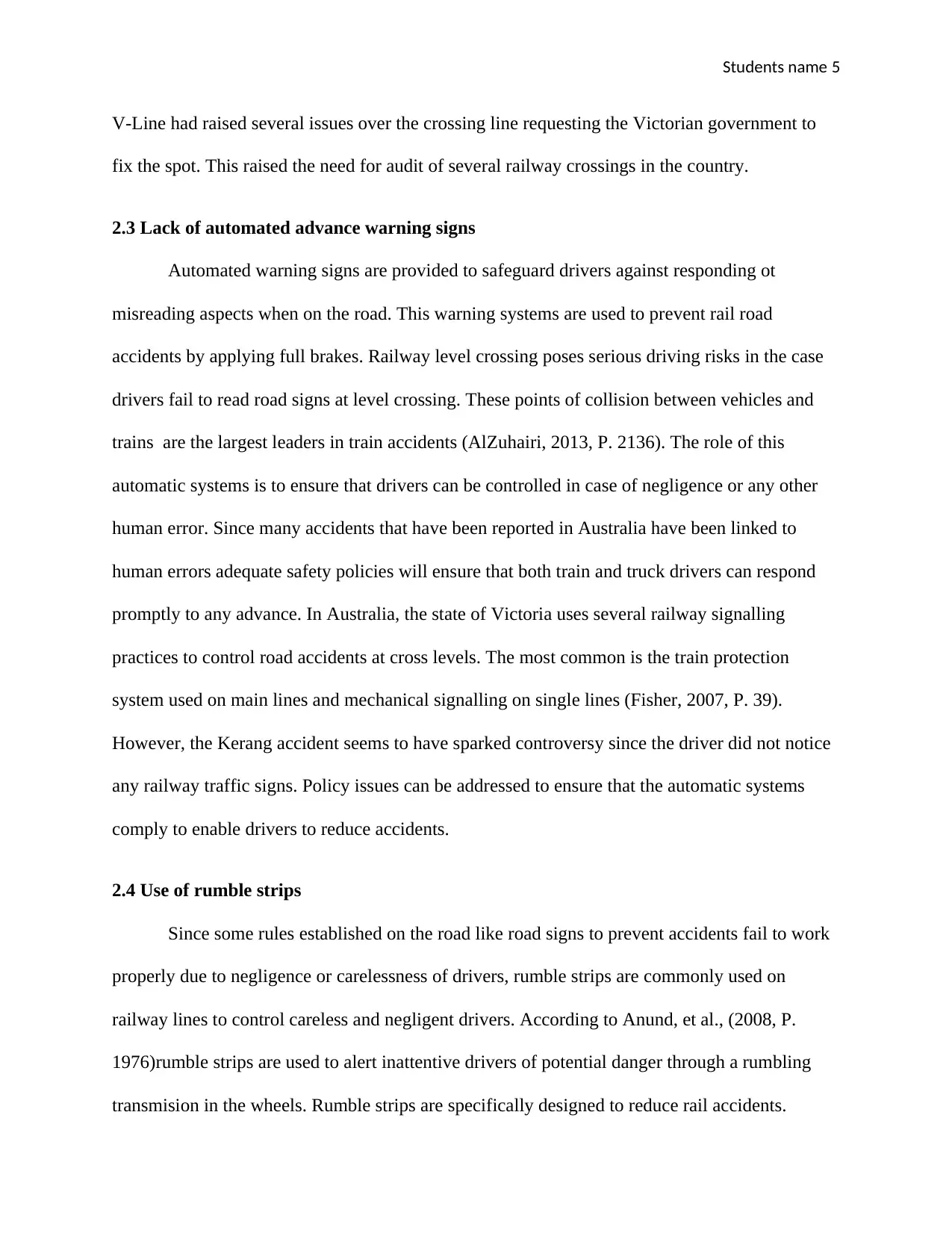
Students name 5
V-Line had raised several issues over the crossing line requesting the Victorian government to
fix the spot. This raised the need for audit of several railway crossings in the country.
2.3 Lack of automated advance warning signs
Automated warning signs are provided to safeguard drivers against responding ot
misreading aspects when on the road. This warning systems are used to prevent rail road
accidents by applying full brakes. Railway level crossing poses serious driving risks in the case
drivers fail to read road signs at level crossing. These points of collision between vehicles and
trains are the largest leaders in train accidents (AlZuhairi, 2013, P. 2136). The role of this
automatic systems is to ensure that drivers can be controlled in case of negligence or any other
human error. Since many accidents that have been reported in Australia have been linked to
human errors adequate safety policies will ensure that both train and truck drivers can respond
promptly to any advance. In Australia, the state of Victoria uses several railway signalling
practices to control road accidents at cross levels. The most common is the train protection
system used on main lines and mechanical signalling on single lines (Fisher, 2007, P. 39).
However, the Kerang accident seems to have sparked controversy since the driver did not notice
any railway traffic signs. Policy issues can be addressed to ensure that the automatic systems
comply to enable drivers to reduce accidents.
2.4 Use of rumble strips
Since some rules established on the road like road signs to prevent accidents fail to work
properly due to negligence or carelessness of drivers, rumble strips are commonly used on
railway lines to control careless and negligent drivers. According to Anund, et al., (2008, P.
1976)rumble strips are used to alert inattentive drivers of potential danger through a rumbling
transmision in the wheels. Rumble strips are specifically designed to reduce rail accidents.
V-Line had raised several issues over the crossing line requesting the Victorian government to
fix the spot. This raised the need for audit of several railway crossings in the country.
2.3 Lack of automated advance warning signs
Automated warning signs are provided to safeguard drivers against responding ot
misreading aspects when on the road. This warning systems are used to prevent rail road
accidents by applying full brakes. Railway level crossing poses serious driving risks in the case
drivers fail to read road signs at level crossing. These points of collision between vehicles and
trains are the largest leaders in train accidents (AlZuhairi, 2013, P. 2136). The role of this
automatic systems is to ensure that drivers can be controlled in case of negligence or any other
human error. Since many accidents that have been reported in Australia have been linked to
human errors adequate safety policies will ensure that both train and truck drivers can respond
promptly to any advance. In Australia, the state of Victoria uses several railway signalling
practices to control road accidents at cross levels. The most common is the train protection
system used on main lines and mechanical signalling on single lines (Fisher, 2007, P. 39).
However, the Kerang accident seems to have sparked controversy since the driver did not notice
any railway traffic signs. Policy issues can be addressed to ensure that the automatic systems
comply to enable drivers to reduce accidents.
2.4 Use of rumble strips
Since some rules established on the road like road signs to prevent accidents fail to work
properly due to negligence or carelessness of drivers, rumble strips are commonly used on
railway lines to control careless and negligent drivers. According to Anund, et al., (2008, P.
1976)rumble strips are used to alert inattentive drivers of potential danger through a rumbling
transmision in the wheels. Rumble strips are specifically designed to reduce rail accidents.
⊘ This is a preview!⊘
Do you want full access?
Subscribe today to unlock all pages.

Trusted by 1+ million students worldwide

Students name 6
Despite the fact that they have been removed in Australia due to complains from the public.
These strips have been helpful in reducing cross level collisions. Since they were removed from
the road, the public has relied heavily on observing road signs like hooting of the train or lights
that indicate the train is near. However, Hensher, et al. (2009, P. 11) argue that drivers may be
careless or they may be concentrating on other things and completely ignore the road signals and
signs. In the case of the Kerang accident, the driver claimed to have realised the presence of the
train when he saw traffic near the rail but it was too late. This is an indicator which shows that
the government needs to have put up a better strategy for alerting inattentive drivers. Distractions
have always existed on the road making it normal for any driver to see a road sign despite the
legal implications of the same.
Despite the blame being apportioned on both trains and trucks, it is evident that there is
lack of adequate road signs in some rural areas in Australia which may increase rail accidents.
Insufficient clear signs at triangles and existing of road contradictions have increased these
accidents. In some areas there are both traffic and rail signs that may offer contradicting
information (Tey & Ferreira, 2013, P. 8). This may increase accident chances since in such cases
drivers will ignore the railway sign and opt for the road sign. In some cases the sign boards used
are too old to the extent that they appear as if a train never uses that route. This places the burden
on the relevant government since there should be policies and practices that guide the way such
signs need to be erected and updated.
3.0 Conclusion
Train accidents in Australia have bee linked to failure to observe road codes that have
been established. However, the challenge has been to prove whether cross level accidents are a
result of poor polices and practices that have led to the signs that need to be used not being
Despite the fact that they have been removed in Australia due to complains from the public.
These strips have been helpful in reducing cross level collisions. Since they were removed from
the road, the public has relied heavily on observing road signs like hooting of the train or lights
that indicate the train is near. However, Hensher, et al. (2009, P. 11) argue that drivers may be
careless or they may be concentrating on other things and completely ignore the road signals and
signs. In the case of the Kerang accident, the driver claimed to have realised the presence of the
train when he saw traffic near the rail but it was too late. This is an indicator which shows that
the government needs to have put up a better strategy for alerting inattentive drivers. Distractions
have always existed on the road making it normal for any driver to see a road sign despite the
legal implications of the same.
Despite the blame being apportioned on both trains and trucks, it is evident that there is
lack of adequate road signs in some rural areas in Australia which may increase rail accidents.
Insufficient clear signs at triangles and existing of road contradictions have increased these
accidents. In some areas there are both traffic and rail signs that may offer contradicting
information (Tey & Ferreira, 2013, P. 8). This may increase accident chances since in such cases
drivers will ignore the railway sign and opt for the road sign. In some cases the sign boards used
are too old to the extent that they appear as if a train never uses that route. This places the burden
on the relevant government since there should be policies and practices that guide the way such
signs need to be erected and updated.
3.0 Conclusion
Train accidents in Australia have bee linked to failure to observe road codes that have
been established. However, the challenge has been to prove whether cross level accidents are a
result of poor polices and practices that have led to the signs that need to be used not being
Paraphrase This Document
Need a fresh take? Get an instant paraphrase of this document with our AI Paraphraser

Students name 7
effective. Most accidents that happen at crossl evels have revealed challenges in the road signs
that are supposesd to guide members of the public in detecting the presence of trains and thus
slowing down. This leads to collisions that claim many lives.
Therefore, the best way of reducing cross level accidents to implement relevant policies
that guide the way traffic needs to run. The road and rail are related components that share routes
and intersect each other oftenly. The government needs to ensure that policies and regulations
are followed to the latter (Tooth & Balmfor, 2010). Policies guide the way the public needs to
respond to reduce accidents. Implementation of such policies requires the government to channel
enough resources towards that course. It is the responsibility of every government to protect its
citizens from any risk that they may face. When designing railways, governments need to enact
laws that guide the way cross levels need to be designed to reduce collision accidents. Therefore,
the back stops with the government through establishing adequate policies and ensuring road
practices are followed as per the requirement. The Kerang crash was led to the need to determine
circumstances that increase accidents and identify safety actions aginst them. Today all state
governments in Australia have put in place policies to reduce cross level accidents through
Transport Safety Investigation Regulations 2003 (TSI Regulations).
effective. Most accidents that happen at crossl evels have revealed challenges in the road signs
that are supposesd to guide members of the public in detecting the presence of trains and thus
slowing down. This leads to collisions that claim many lives.
Therefore, the best way of reducing cross level accidents to implement relevant policies
that guide the way traffic needs to run. The road and rail are related components that share routes
and intersect each other oftenly. The government needs to ensure that policies and regulations
are followed to the latter (Tooth & Balmfor, 2010). Policies guide the way the public needs to
respond to reduce accidents. Implementation of such policies requires the government to channel
enough resources towards that course. It is the responsibility of every government to protect its
citizens from any risk that they may face. When designing railways, governments need to enact
laws that guide the way cross levels need to be designed to reduce collision accidents. Therefore,
the back stops with the government through establishing adequate policies and ensuring road
practices are followed as per the requirement. The Kerang crash was led to the need to determine
circumstances that increase accidents and identify safety actions aginst them. Today all state
governments in Australia have put in place policies to reduce cross level accidents through
Transport Safety Investigation Regulations 2003 (TSI Regulations).
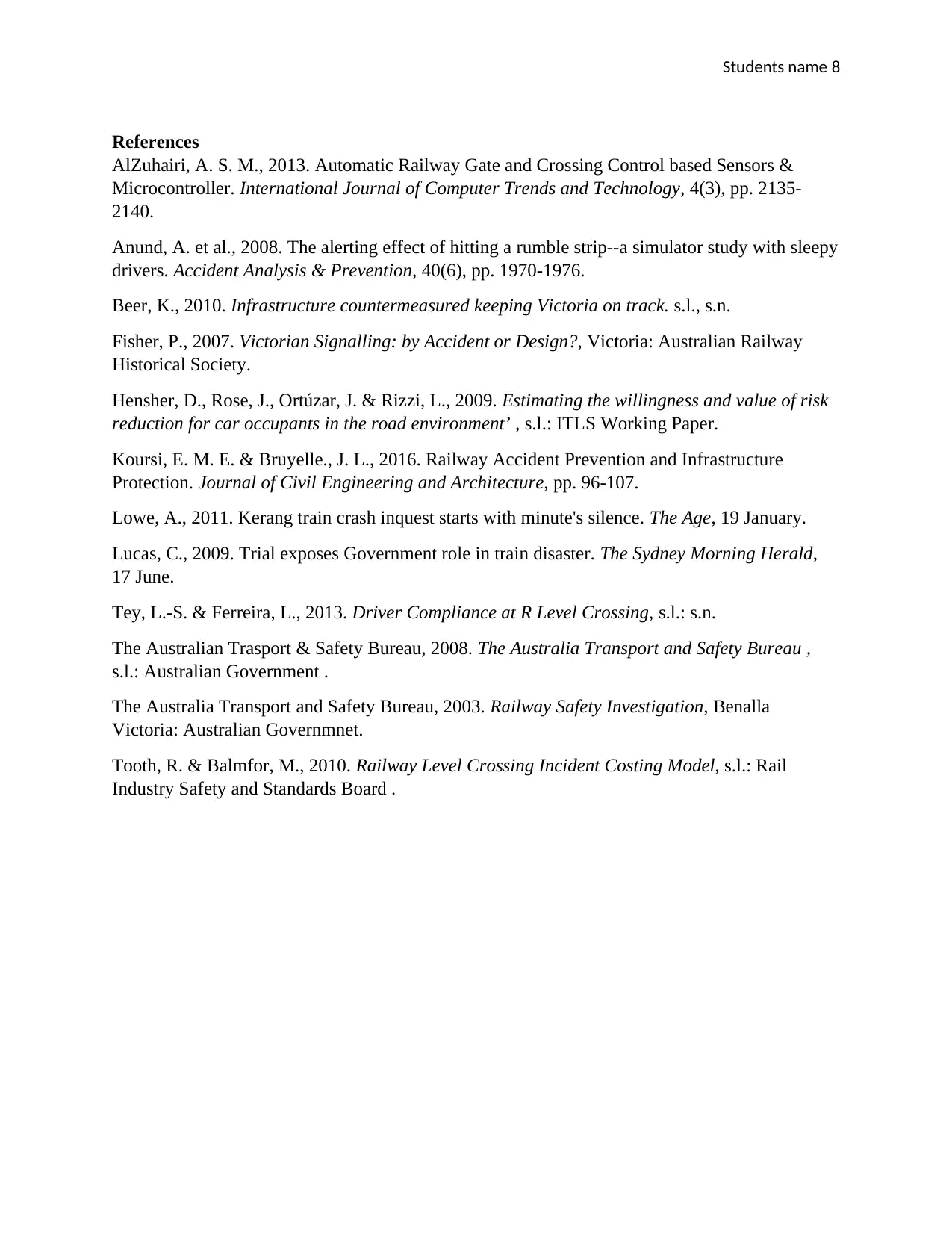
Students name 8
References
AlZuhairi, A. S. M., 2013. Automatic Railway Gate and Crossing Control based Sensors &
Microcontroller. International Journal of Computer Trends and Technology, 4(3), pp. 2135-
2140.
Anund, A. et al., 2008. The alerting effect of hitting a rumble strip--a simulator study with sleepy
drivers. Accident Analysis & Prevention, 40(6), pp. 1970-1976.
Beer, K., 2010. Infrastructure countermeasured keeping Victoria on track. s.l., s.n.
Fisher, P., 2007. Victorian Signalling: by Accident or Design?, Victoria: Australian Railway
Historical Society.
Hensher, D., Rose, J., Ortúzar, J. & Rizzi, L., 2009. Estimating the willingness and value of risk
reduction for car occupants in the road environment’ , s.l.: ITLS Working Paper.
Koursi, E. M. E. & Bruyelle., J. L., 2016. Railway Accident Prevention and Infrastructure
Protection. Journal of Civil Engineering and Architecture, pp. 96-107.
Lowe, A., 2011. Kerang train crash inquest starts with minute's silence. The Age, 19 January.
Lucas, C., 2009. Trial exposes Government role in train disaster. The Sydney Morning Herald,
17 June.
Tey, L.-S. & Ferreira, L., 2013. Driver Compliance at R Level Crossing, s.l.: s.n.
The Australian Trasport & Safety Bureau, 2008. The Australia Transport and Safety Bureau ,
s.l.: Australian Government .
The Australia Transport and Safety Bureau, 2003. Railway Safety Investigation, Benalla
Victoria: Australian Governmnet.
Tooth, R. & Balmfor, M., 2010. Railway Level Crossing Incident Costing Model, s.l.: Rail
Industry Safety and Standards Board .
References
AlZuhairi, A. S. M., 2013. Automatic Railway Gate and Crossing Control based Sensors &
Microcontroller. International Journal of Computer Trends and Technology, 4(3), pp. 2135-
2140.
Anund, A. et al., 2008. The alerting effect of hitting a rumble strip--a simulator study with sleepy
drivers. Accident Analysis & Prevention, 40(6), pp. 1970-1976.
Beer, K., 2010. Infrastructure countermeasured keeping Victoria on track. s.l., s.n.
Fisher, P., 2007. Victorian Signalling: by Accident or Design?, Victoria: Australian Railway
Historical Society.
Hensher, D., Rose, J., Ortúzar, J. & Rizzi, L., 2009. Estimating the willingness and value of risk
reduction for car occupants in the road environment’ , s.l.: ITLS Working Paper.
Koursi, E. M. E. & Bruyelle., J. L., 2016. Railway Accident Prevention and Infrastructure
Protection. Journal of Civil Engineering and Architecture, pp. 96-107.
Lowe, A., 2011. Kerang train crash inquest starts with minute's silence. The Age, 19 January.
Lucas, C., 2009. Trial exposes Government role in train disaster. The Sydney Morning Herald,
17 June.
Tey, L.-S. & Ferreira, L., 2013. Driver Compliance at R Level Crossing, s.l.: s.n.
The Australian Trasport & Safety Bureau, 2008. The Australia Transport and Safety Bureau ,
s.l.: Australian Government .
The Australia Transport and Safety Bureau, 2003. Railway Safety Investigation, Benalla
Victoria: Australian Governmnet.
Tooth, R. & Balmfor, M., 2010. Railway Level Crossing Incident Costing Model, s.l.: Rail
Industry Safety and Standards Board .
⊘ This is a preview!⊘
Do you want full access?
Subscribe today to unlock all pages.

Trusted by 1+ million students worldwide
1 out of 9
Related Documents
Your All-in-One AI-Powered Toolkit for Academic Success.
+13062052269
info@desklib.com
Available 24*7 on WhatsApp / Email
![[object Object]](/_next/static/media/star-bottom.7253800d.svg)
Unlock your academic potential
Copyright © 2020–2025 A2Z Services. All Rights Reserved. Developed and managed by ZUCOL.





